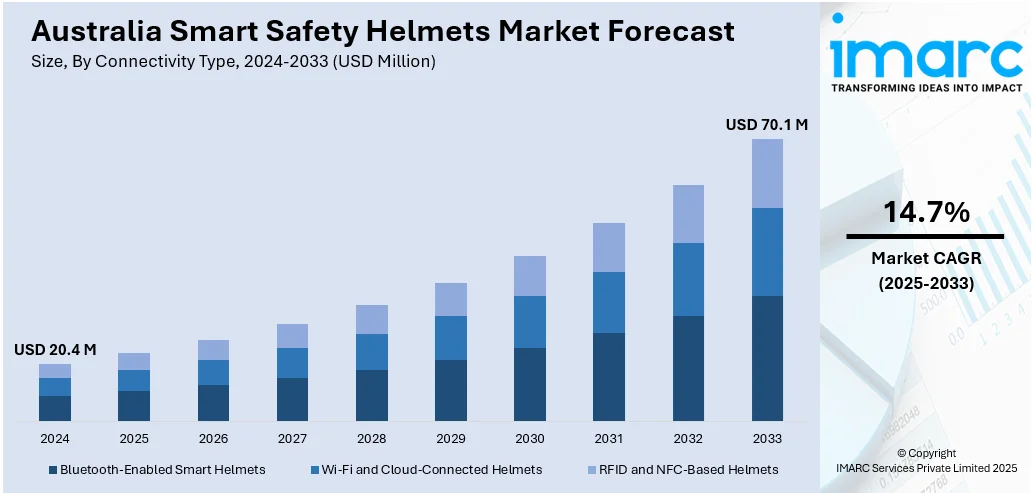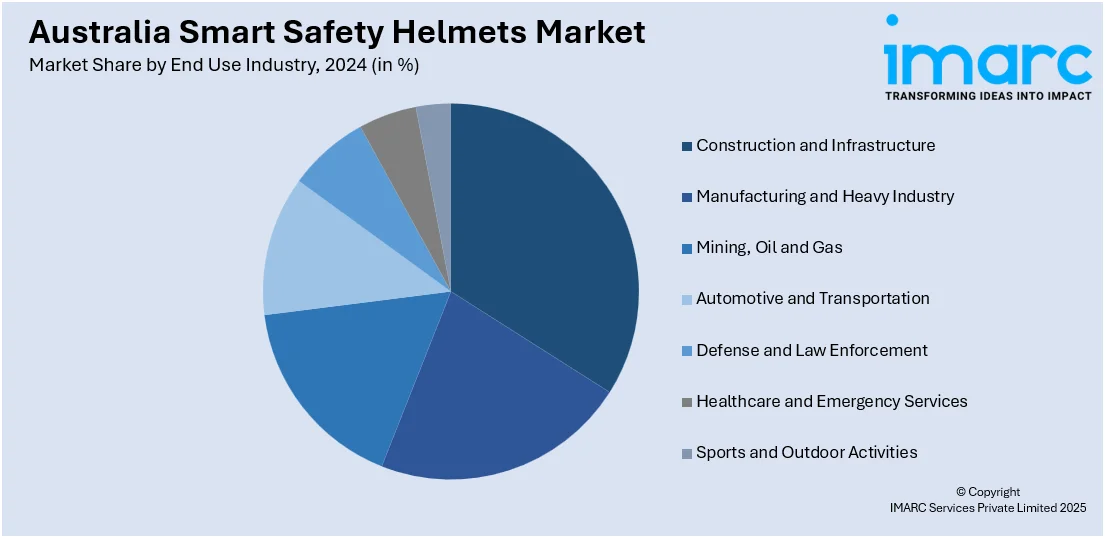
Australia Smart Safety Helmets Market Size, Share, Trends and Forecast by Technology Type, Connectivity Type, Material Type, Safety Features, End Use Industry, and Region, 2025-2033
Australia Smart Safety Helmets Market Overview:
The Australia smart safety helmets market size reached USD 20.4 Million in 2024. Looking forward, IMARC Group expects the market to reach USD 70.1 Million by 2033, exhibiting a growth rate (CAGR) of 14.7% during 2025-2033. The market is witnessing significant growth due to rising workplace safety regulations, growing adoption of wearable technology, and increased focus on worker health monitoring across mining, construction, and industrial sectors. Development of smart safety helmets with features like GPS tracking, health monitoring, and AR integration that enhance operational efficiency and worker protection, technological advancements and regulatory compliance are other key drivers influencing the Australia smart safety helmets market share.
|
Report Attribute
|
Key Statistics
|
|---|---|
|
Base Year
|
2024 |
|
Forecast Years
|
2025-2033
|
|
Historical Years
|
2019-2024
|
| Market Size in 2024 | USD 20.4 Million |
| Market Forecast in 2033 | USD 70.1 Million |
| Market Growth Rate (2025-2033) | 14.7% |
Australia Smart Safety Helmets Market Trends:
Integration of Augmented Reality (AR)
The integration of Augmented Reality (AR) is emerging as a transformative trend in the Australia smart safety helmets market. AR-enabled helmets provide users with real-time visual data allowing them to access schematics, safety alerts, and maintenance instructions directly within their field of view. This reduces the need for handheld devices or frequent consultation of manuals, thereby improving on-site efficiency and safety. In sectors like construction, mining, and utilities, workers can receive remote guidance from off-site experts through live video feeds, enabling quicker problem resolution and reducing downtime. AR features also support training initiatives by simulating real-world scenarios, making learning more interactive and practical. As industries seek to minimize risks and streamline operations, the demand for smart helmets with AR functionality is expected to grow, contributing to safer, more productive work environments across high-risk job sites in Australia.

To get more information on this market, Request Sample
Health and Fatigue Monitoring
Health and fatigue monitoring is also emerging as a key function in smart safety helmets, particularly in high-risk Australian sectors like mining, construction, and oil and gas. Integrate sensors track important vital signs such as heart rate, body temperature, and head movement patterns to identify physical distress or signs of fatigue. These information points are reported in real-time to safety managers, allowing them to intervene instantaneously when an employee exhibits initial signs of fatigue or health abnormalities. By spotting and mitigating fatigue-related risks beforehand, firms can avoid accidents, minimize downtime, and guarantee improved worker welfare. This capability is especially beneficial in remote and unforgiving environments where rapid medical intervention may not be readily accessible. The focus on employee safety, combined with regulatory pressure to improve workplace health standards, is driving demand for such advanced features, directly contributing to Australia smart safety helmets market growth.
Growing Demand for IoT and Connectivity Features
IoT and connectivity capabilities are increasingly becoming a part of smart safety helmet development, improving safety as well as operational effectiveness. GPS, Bluetooth, and Wi-Fi-enabled helmets facilitate real-time location tracking, which helps supervisors monitor the movement of workers on vast or dangerous locations. In case of emergencies, immediate alerts can be initiated and shared among teams, reducing response times considerably. Bluetooth connectivity provides for hands-free talk, allowing employees to remain in touch without being interrupted from their work, and Wi-Fi access provides for the transmission of data for remote diagnosis, updates, or live video assistance. Such capabilities are particularly useful in such sectors as construction, utilities, and logistics, where coordination and real-time consciousness are essential. Through the fusion of IoT technologies, intelligent helmets evolve from reactive safety equipment into proactive workforce management tools, yielding enhanced site insight, worker accountability, and intelligent decision-making on Australia's industrial sites.
Australia Smart Safety Helmets Market Segmentation:
IMARC Group provides an analysis of the key trends in each segment of the market, along with forecasts at the country and regional levels for 2025-2033. Our report has categorized the market based on technology type, connectivity type, material type, safety features, and end use industry.
Technology Type Insights:
- IoT-Enabled Smart Helmets
- Augmented Reality (AR) and Heads-Up Display (HUD) Helmets
- AI-Powered Safety Helmets
- Sensor-Based Smart Helmets
- GPS-Enabled Helmets
- Communication-Integrated Helmets
The report has provided a detailed breakup and analysis of the market based on the technology type. This includes IoT-enabled smart helmets, augmented reality (AR) and heads-up display (HUD) helmets, AI-powered safety helmets, sensor-based smart helmets, GPS-enabled helmets, and communication-integrated helmets.
Connectivity Type Insights:
- Bluetooth-Enabled Smart Helmets
- Wi-Fi and Cloud-Connected Helmets
- RFID and NFC-Based Helmets
A detailed breakup and analysis of the market based on the connectivity have also been provided in the report. This includes Bluetooth-enabled smart helmets, Wi-Fi and cloud-connected helmets, and RFID and NFC-based helmets.
Material Type Insights:
- Polycarbonate Helmets
- Fiberglass and Composite Helmets
- ABS Plastic Helmets
- Carbon Fiber Helmets
A detailed breakup and analysis of the market based on the material type have also been provided in the report. This includes polycarbonate helmets, fiberglass and composite helmets, ABS plastic helmets, and carbon fiber helmets.
Safety Features Insights:
- Real-Time Health Monitoring
- Fall and Impact Detection
- Noise Cancellation and Communication Enhancement
- Fire and Hazard Detection
- Environmental Monitoring
- Smart Lighting and Alerts
A detailed breakup and analysis of the market based on the safety features have also been provided in the report. This includes real-time health monitoring, fall and impact detection, noise cancellation and communication enhancement, fire and hazard detection, environmental monitoring, and smart lighting and alerts.
End Use Industry Insights:

- Construction and Infrastructure
- Manufacturing and Heavy Industry
- Mining, Oil and Gas
- Automotive and Transportation
- Defense and Law Enforcement
- Healthcare and Emergency Services
- Sports and Outdoor Activities
A detailed breakup and analysis of the market based on the end use industry have also been provided in the report. This includes construction and infrastructure, manufacturing and heavy industry, mining, oil and gas, automotive and transportation, defense and law enforcement, healthcare and emergency services, and sports and outdoor activities.
Regional Insights:
- Australia Capital Territory & New South Wales
- Victoria & Tasmania
- Queensland
- Northern Territory & South Australia
- Western Australia
The report has also provided a comprehensive analysis of all the major regional markets, which include Australia Capital Territory & New South Wales, Victoria & Tasmania, Queensland, Northern Territory & Southern Australia, and Western Australia.
Competitive Landscape:
The market research report has also provided a comprehensive analysis of the competitive landscape. Competitive analysis such as market structure, key player positioning, top winning strategies, competitive dashboard, and company evaluation quadrant has been covered in the report. Also, detailed profiles of all major companies have been provided.
Australia Smart Safety Helmets Market News:
- In January 2024, GoPro acquired Sydney-based Forcite Helmet Systems, known for integrating safety and GPS technology into motorcycle helmets. This partnership aims to enhance helmet safety and performance, starting with motorcycle models. GoPro plans to develop its own branded helmets and collaborate with other brands to tech-enable their products.
Australia Smart Safety Helmets Market Report Coverage:
| Report Features | Details |
|---|---|
| Base Year of the Analysis | 2024 |
| Historical Period | 2019-2024 |
| Forecast Period | 2025-2033 |
| Units | Million USD |
| Scope of the Report | Exploration of Historical Trends and Market Outlook, Industry Catalysts and Challenges, Segment-Wise Historical and Future Market Assessment:
|
| Technology Types | IoT-Enabled Smart Helmets, Augmented Reality (AR) and Heads-Up Display (HUD) Helmets, AI-Powered Safety Helmets, Sensor-Based Smart Helmets, GPS-Enabled Helmets, Communication-Integrated Helmets |
| Connectivity Types | Bluetooth-Enabled Smart Helmets, Wi-Fi and Cloud-Connected Helmets, RFID and NFC-Based Helmets |
| Material Types | Polycarbonate Helmets, Fiberglass and Composite Helmets, ABS Plastic Helmets, Carbon Fiber Helmets |
| Safety Features | Real-Time Health Monitoring, Fall and Impact Detection, Noise Cancellation and Communication Enhancement, Fire and Hazard Detection, Environmental Monitoring, Smart Lighting and Alerts |
| End-Use Industries | Construction and Infrastructure, Manufacturing and Heavy Industry, Mining, Oil and Gas, Automotive and Transportation, Defense and Law Enforcement, Healthcare and Emergency Services, Sports and Outdoor Activities |
| Regions Covered | Australia Capital Territory & New South Wales, Victoria & Tasmania, Queensland, Northern Territory & Southern Australia, Western Australia |
| Customization Scope | 10% Free Customization |
| Post-Sale Analyst Support | 10-12 Weeks |
| Delivery Format | PDF and Excel through Email (We can also provide the editable version of the report in PPT/Word format on special request) |
Key Questions Answered in This Report:
- How has the Australia smart safety helmets market performed so far and how will it perform in the coming years?
- What is the breakup of the Australia smart safety helmets market on the basis of technology type?
- What is the breakup of the Australia smart safety helmets market on the basis of connectivity type?
- What is the breakup of the Australia smart safety helmets market on the basis of material type?
- What is the breakup of the Australia smart safety helmets market on the basis of safety features?
- What is the breakup of the Australia smart safety helmets market on the basis of end use industry?
- What is the breakup of the Australia smart safety helmets market on the basis of region?
- What are the various stages in the value chain of the Australia smart safety helmets market?
- What are the key driving factors and challenges in the Australia smart safety helmets market?
- What is the structure of the Australia smart safety helmets market and who are the key players?
- What is the degree of competition in the Australia smart safety helmets market?
Key Benefits for Stakeholders:
- IMARC’s industry report offers a comprehensive quantitative analysis of various market segments, historical and current market trends, market forecasts, and dynamics of the Australia smart safety helmets market from 2019-2033.
- The research report provides the latest information on the market drivers, challenges, and opportunities in the Australia smart safety helmets market.
- Porter's five forces analysis assist stakeholders in assessing the impact of new entrants, competitive rivalry, supplier power, buyer power, and the threat of substitution. It helps stakeholders to analyze the level of competition within the Australia smart safety helmets industry and its attractiveness.
- Competitive landscape allows stakeholders to understand their competitive environment and provides an insight into the current positions of key players in the market.
Need more help?
- Speak to our experienced analysts for insights on the current market scenarios.
- Include additional segments and countries to customize the report as per your requirement.
- Gain an unparalleled competitive advantage in your domain by understanding how to utilize the report and positively impacting your operations and revenue.
- For further assistance, please connect with our analysts.
 Request Customization
Request Customization
 Speak to an Analyst
Speak to an Analyst
 Request Brochure
Request Brochure
 Inquire Before Buying
Inquire Before Buying




.webp)




.webp)












